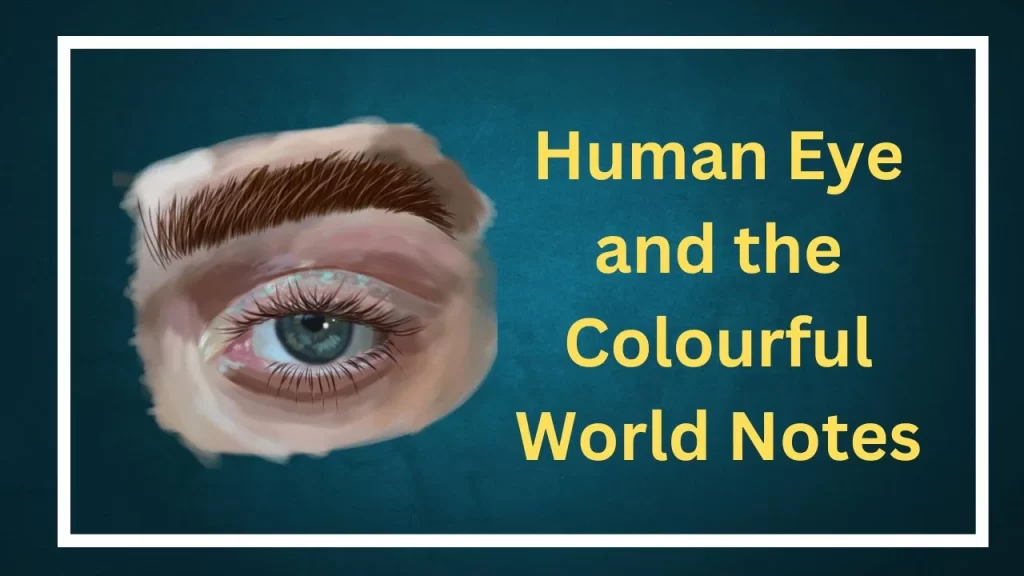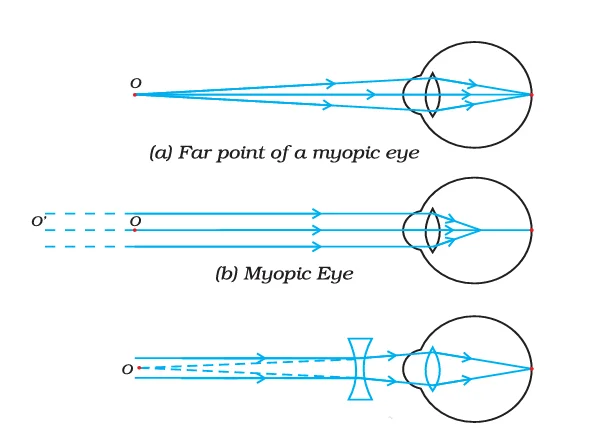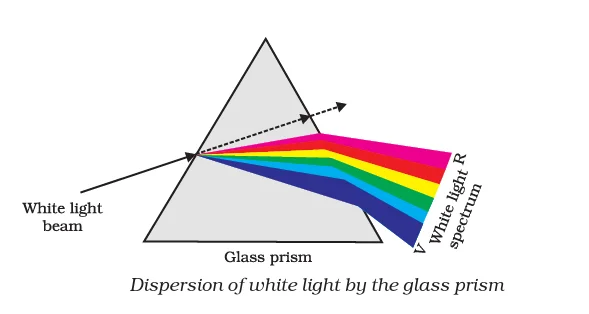Tag: the human eye and the colourful world notes
Human Eye and the Colourful World Notes Chapter 10 Science
In the class 10 Science chapter, “The Human Eye and the Colourful World Notes,” students delve into the application of light knowledge and its properties, previously studied in other chapters. The focus is on understanding how these concepts relate to the human eye.
Additionally, students explore various optical phenomena, including the nature and formation of rainbows, the splitting of white light, and the intriguing phenomenon of the blue color of the sky.
Human Eye and the Colourful World Notes

Structure of a Human Eye
Among all the sense organs, the human eye holds paramount importance, as it grants us the ability to perceive the enchanting and colorful world that surrounds us.
This remarkable organ takes on a spherical shape, with an average diameter of 2.3 cm. Internally, the eye comprises several essential components, such as the cornea, iris, pupil, lens, ciliary muscles, retina, nerve cells, optic nerve, yellow spot, aqueous and vitreous humor, and suspensory ligament.
These intricately interwoven elements work in harmony to facilitate our vision and visual experiences.
The human eye’s lens system plays a crucial role in forming an image on the retina, the light-sensitive screen within the eye. Light enters through the thin membrane known as the cornea, where most of the light refraction occurs at its outer surface. Positioned behind the cornea is the iris, a dark muscular diaphragm responsible for controlling the size of the pupil. The pupil itself acts as a structure that regulates the amount of light entering the eye.
When light illuminates the retina, the light-sensitive cells are activated, triggering electrical signals. These signals are then transmitted to the brain via the optic nerves. The brain undertakes a complex analysis of these signals and processes the information, allowing us to perceive objects as they truly are. In this intricate process, our eyes enable us to perceive the world around us with clarity and precision.

Defects of a Human Eye
Various common eye disorders affect individuals due to a combination of factors, but fortunately, many of these conditions can be improved through corrective measures. Some of the prevalent eye defects include:
1. Myopia (Short-sightedness): Individuals with myopia have clear vision for nearby objects but struggle to see distant objects. A concave lens can effectively correct this condition.

2. Hypermetropia (Farsightedness): People with hypermetropia experience clear vision for distant objects but face difficulty in seeing nearby objects. This defect can be corrected using a convex lens.
3. Presbyopia: This age-related condition arises from weakened ciliary muscles, hardened lens, and reduced lens flexibility. It leads to difficulties in focusing on nearby objects and makes reading and writing challenging.
4. Cataract: Another age-related condition, cataract, occurs when lens proteins erode, causing loss of lens transparency. This results in blurry vision and cloudy lenses, but it can be treated by replacing the affected lens with an artificial one.
In understanding and addressing these eye disorders, modern advancements in corrective procedures have significantly improved the quality of life for those affected.
Dispersion of White Light by a Glass Prism
When a prism is introduced to incident white light, it effectively separates it into a beautiful band of seven colors. This band of colored components is known as the spectrum of the light beam. The credit for the first successful observation of sunlight spectrum through a glass prism goes to Isaac Newton.

As light passes through a prism, different colors bend at varying angles with respect to the incident ray. Among them, red light bends the least, while violet light bends the most. Consequently, each color follows a distinct path, leading to their individual emergence and distinct appearance. This captivating phenomenon allows us to witness the mesmerizing array of colors constituting the visible spectrum.
Atmospheric Refraction
Atmospheric refraction refers to the bending of light by Earth’s atmosphere, caused by the varying optical densities of its different layers.
The twinkling effect of stars is a result of atmospheric refraction of starlight. When starlight passes through the atmosphere on its way to Earth, it undergoes continuous refraction due to the changing densities of the atmosphere. As a consequence, the path of light rays from the star slightly fluctuates, causing the apparent position of the star to waver. This continuous variation in the perceived position of the star leads to the flickering of starlight entering our eyes, giving rise to the captivating twinkling phenomenon we observe in the night sky.
Scattering of Light
As a light beam travels through a medium, it interacts with the particles present in the medium. During this interaction, some of the light rays are absorbed, while others are scattered in different directions. The extent of scattering and the intensity of the scattered light depend on both the size of the particles and the wavelength of the light.

Read Also
- Chemical Reactions and Equations
- Acids, Bases and Salts
- Life Processes
- Control and Coordination
- How Do Organisms Reproduce?
- Heredity and Evolution
- Electricity
- Metals and Non Metals Class 10 NCERT Science Chapter 3 Notes
- Magnetic Effects of Electric Current
- Our Environment
Frequently Asked Questions on Human Eye and the Colourful World Notes
Q 1: How does the eye work Class 10 notes?
The human eye functions like a complex optical system. Light enters the eye through the cornea and pupil. The iris adjusts the size of the pupil to regulate the amount of light entering. The light then passes through the lens, which focuses it onto the retina.
The retina contains light-sensitive cells called rods and cones, which convert light into electrical signals. These signals are transmitted through the optic nerve to the brain for processing. The brain interprets these signals to create visual perceptions. This intricate process enables us to see and perceive the world around us.
Q 2: What are the parts of the eye Class 10 notes?
On average, the eye is a spherical organ with a diameter of approximately 2.3 cm. Internally, it comprises several essential structures, including the cornea, iris, pupil, lens, ciliary muscles, retina, nerve cells, optic nerve, yellow spot, aqueous and vitreous humor, as well as the suspensory ligament. These intricately interconnected components work in harmony to enable vision and the processing of visual information, facilitating our perception of the surrounding world.
Q 3: What are the 5 main parts of the eye?
The key components responsible for your vision include:
1. Cornea: Positioned at the front of your eye, the cornea is a dome-shaped layer that bends the incoming light, directing it further into your eye.
2. Pupil: Acting as a gateway for light, the pupil is the black dot situated in the center of your eye. It expands in dim light and contracts in bright light, its size regulated by the iris.
3. Iris: Commonly known as your eye color, the iris is a muscular structure controlling the pupil’s size and regulating the amount of light entering your eye.
4. Lens: Located behind the iris and pupil, the lens collaborates with the cornea to focus incoming light, much like a camera lens. It sharpens the image before you, allowing clear and detailed vision.
5. Retina: Situated at the back of the eye, the retina is a layer of tissue that converts incoming light into electrical signals. These signals are then transmitted to the brain, where they are interpreted as images, enabling you to see the world around you.
Q 4: Which gland is found in human eye?
The meibomian glands are oil glands located along the edge of the eyelids, where the eyelashes are present. These glands secrete an oily layer that forms the outer part of the tear film, which helps prevent tears from evaporating too rapidly. Various eye problems can be associated with the meibomian glands and their proper functioning.
Q 5: What is eye number?
“Eye number” typically refers to a measurement of refractive error in the eyes, also known as the prescription for corrective lenses. It is denoted in units called diopters (D). When light enters the eye, it should focus precisely on the retina for clear vision. However, in some individuals, the light either falls short of or goes beyond the retina, causing blurry vision. This condition can be categorized into myopia (nearsightedness), hypermetropia (farsightedness), and astigmatism. Eye number determines the strength of lenses needed to correct these refractive errors, allowing the light to focus correctly on the retina and providing clear vision.